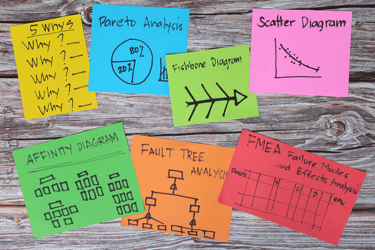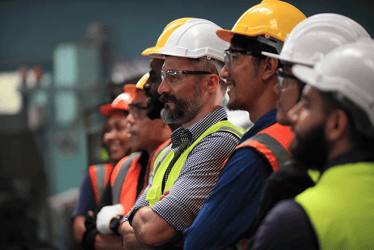The Packaging Industry's Sustainability Challenge: Why ERP Systems Are Essential for Success A straightforward guide to navigating sustainability regulations across folding carton, flexible...
A Glossary of Essential Terms in the Flexible Packaging Industry
Whether you’re new to the industry or a seasoned professional, understanding key terms can help you navigate discussions, make informed decisions, and stay ahead of industry trends.
Here’s a comprehensive glossary covering the most important terms used across the flexible packaging sector.
A–Z Glossary Contents
A
- Adhesive Lamination: A process where multiple layers of film or foil are bonded using an adhesive to create multi-layered packaging.
- Anti-Fog Coating: A special coating applied to packaging films to prevent condensation and ensure product visibility.
- Autoclave: A high-pressure steam sterilization process used in the production of sterilizable flexible packaging.
B
- Barrier Properties: The ability of a packaging material to resist the passage of gases, moisture, and light to extend product shelf life.
- Blown Film Extrusion: A manufacturing process that produces flexible plastic film by inflating molten polymer into a bubble.
- BOPP (Biaxially Oriented Polypropylene): A widely used film in flexible packaging known for its strength, clarity, and barrier properties.
C
- Cast Film: A plastic film produced by extruding molten polymer onto a chill roll, resulting in a smooth and transparent surface.
- Cold Seal: A type of adhesive that bonds at room temperature when pressure is applied, commonly used for confectionery and snack packaging.
- Coextrusion: The process of extruding multiple layers of plastic film simultaneously to enhance strength, barrier properties, and functionality.
D
- Die-Cutting: The process of cutting flexible packaging materials into specific shapes using a metal die.
- Doypack (Stand-Up Pouch): A flexible pouch with a bottom gusset that allows it to stand upright for display and storage.
- Digital Printing: A printing technique that uses digital files rather than printing plates, allowing for high customization and short print runs.
E
- Easy-Open Feature: Design elements such as tear notches and laser scoring that facilitate easy opening of packaging.
- Extruder: The machine that melts and pushes plastic through a die to form films or sheets, consisting of a heated barrel, rotating screw, and die.
- Extrusion: A process in which molten plastic is forced through a shaped die to create continuous films, coatings, or laminates used in flexible packaging.
- Extrusion Coating: A process in which molten resin is applied to a substrate, such as paper or foil, to enhance its properties.
F
- Flexographic Printing (Flexo): A high-speed printing process using flexible rubber printing plates and fast-drying inks, commonly used for flexible packaging.
- Form-Fill-Seal (FFS): A packaging process where a machine forms the package, fills it with product, and seals it in one continuous operation.
G
- Gravure Printing: A printing process that uses engraved cylinders to transfer ink onto packaging material, known for high-quality images and consistency.
- Gusset: A fold in flexible packaging that expands to accommodate contents, commonly found in pouches and bags.
H
- Heat Seal: A method of sealing flexible packaging using heat and pressure to create an airtight closure.
- High-Density Polyethylene (HDPE): A type of plastic used in flexible packaging that offers durability, moisture resistance, and recyclability.
I
- Ink Adhesion: The ability of ink to adhere to packaging material, affecting print quality and durability.
- Induction Sealing: A non-contact sealing method that uses electromagnetic energy to bond a foil liner to a container’s opening.
L
- Lidding Film: A flexible film used to seal trays, cups, or containers while allowing for easy peel-off or puncture access.
- Low-Density Polyethylene (LDPE): A flexible, lightweight plastic used in pouches, bags, and shrink wrap.
M
- Modified Atmosphere Packaging (MAP): A packaging technology that alters the internal atmosphere to extend shelf life by controlling oxygen, carbon dioxide, and nitrogen levels.
- Monomaterial Packaging: Packaging made from a single type of material to improve recyclability and sustainability.
O
- OPP (Oriented Polypropylene): A plastic film used for its transparency, gloss, and resistance to moisture.
- Overwrap: A flexible substrate, typically film or paper, used to wrap products individually or in multipacks for protection and shelf appeal.
P
- PE (Polyethylene): A common plastic polymer used in various flexible packaging applications due to its strength and flexibility.
- Pouch Converting: The process of manufacturing flexible pouches by cutting, folding, and sealing films.
- PP (Polypropylene): A lightweight, durable plastic with excellent moisture resistance used in flexible packaging.
R
- Recyclable Packaging: Packaging designed to be processed and reused in recycling systems to minimize environmental impact.
- Retort Pouch: A heat-resistant pouch designed for the sterilization and long-term storage of food products.
S
- Shelf Life: The period during which a packaged product remains safe and maintains its intended quality.
- Shrink Film: A film that shrinks tightly around a product when heat is applied, commonly used for tamper-evident packaging.
- Solvent-Based Inks: Printing inks that use organic solvents, offering durability and high-quality print results.
T
- Tear Notch: A small cut in flexible packaging that allows for easy opening without the need for scissors.
- Thermoforming: A process where plastic sheets are heated and molded into specific shapes for trays and containers.
- Three-Side Seal Pouch: A pouch sealed on three sides, leaving one side open for filling before final sealing.
W
- Water-Based Inks: Printing inks that use water as a solvent, reducing volatile organic compounds (VOCs) for eco-friendliness.
- Wraparound Label: A label that wraps around the entire circumference of a product, commonly used for bottles and flexible packaging.
Conclusion
Understanding flexible packaging terminology is essential for professionals across the industry, from manufacturers and suppliers to brand owners and retailers. As packaging technology continues to advance, staying familiar with these key terms will help you navigate new innovations, flexible packaging trends, regulatory requirements, and sustainability initiatives.
Is there a term you’d like to see added to the glossary? Contact us to let us know!



